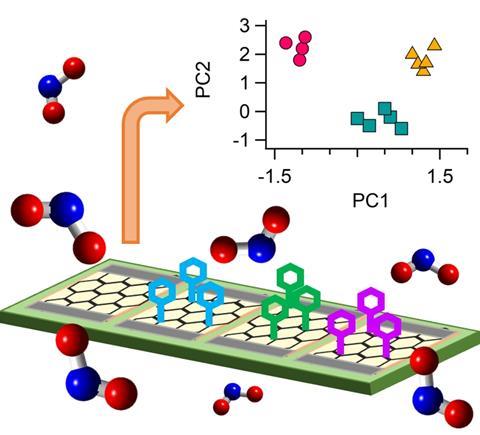An electronic nose based on covalently modified graphene is very sensitive to nitrogen dioxide, according to an Italian-Flemish team in Chemistry A European Journal.

Nitrogen dioxide (NO2) is one of the most common air pollutants and affects the lungs. It is also a biomarker for people with COPD or childhood asthma. It is therefore important to be able to detect it. With this in mind, the groups of Luigi Sangaletti (Università Cattolica del Sacro Cuore) and Steven De Feyter (KU Leuven) have developed an electronic nose (e-nose) that is still sensitive to NO2 from a mixture of gases.
They made the e-nose based on graphene, which they decorated with three different diazonium salts: 4-bromophenyl, 4-carboxyphenyl and 4-nitrophenyl. This gave them three sensors, which they placed side by side on an electronic circuit board with a slice of pure graphene. When exposed to NO2, the resistance indicates that the gas binds to the sensors. Compared to pure graphene, the sensors react and recover much faster. The limit of the sensors was also lower: 0.5-2.7 ppb compared to 200 ppb for pure graphene.
They then looked at how the sensors responded to other gases. ‘We looked at gases that would interfere with NO2’, says first author Sonia Freddi, who works in both groups. They found that the sensors did indeed register most of the gases. ‘The next step was to mix NO2 with other gases to see how the NO2 signal compared with the other signals.’ It turned out that, based on these measurements, you could indeed distinguish NO2 from such a mixture of gases.
Afterwards, they unleashed an algorithm on the data they had generated. ‘I first had to teach the algorithm which signals indicated which gases’, says Freddi. ‘Then we did a blind test: can the algorithm identify the correct gas without any further clues? It did, using linear discriminant analysis.’ They created two categories, NO2 and all gases except NO2, and ran tests on them. Even with the limited data set of between 20 and 40, the algorithm managed to make a correct prediction in 95% of cases, making the move to applications very attractive.
Freddi, S. et al. (2023) Chem. Eur. J. e202302154, DOI: 10.1002/chem.202302154












Nog geen opmerkingen